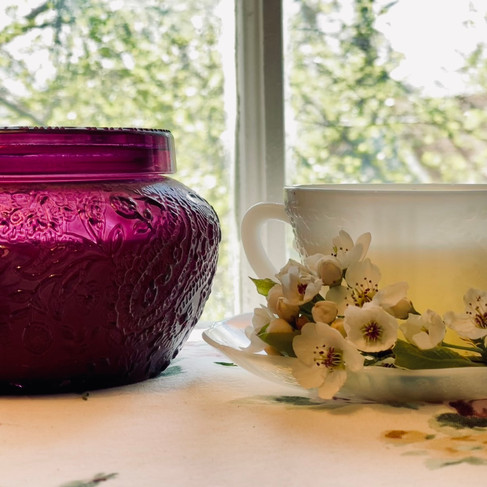Hanami – Spring Cherry Blossom Viewing Teatime
- janaejean
- Apr 29, 2022
- 4 min read
Updated: May 2, 2022
The Ephemeral Beauty of Spring

In the city fields
Contemplating cherry-trees...
Strangers are like friends
– Kobayashi Issa, 小林 一茶 (June 15, 1763 – Jan.5, 1828)
After months of being indoors and keeping cozy, spring has finally arrived. We emerge from our cocoons, ready to interact with the world again. Japanese poet, Kobayashi Nobuyuk (小林 信之) known by his pen name of Issa (一茶) penned the above haiku, which reminds us that under the blossoming trees in the spring we are all "like friends" as we share the experience. Kobayashi's pen name Issa means literally "cup of tea."
Hanami (literally "flower viewing") is an annual event in starting in East Asia and now celebrated around the world to hail the return of spring. It is a celebration of the delicate and ephermal blossoms beginning with ume (plum blossoms), followed by sakura (cherry blossoms). In Japan, family and friends gather under the trees to admire the blossoms while sharing food and drink while the petals fall waft from the trees like rose-colored "snow". The tradition has spread to other countries as well.
Cherry Blossom Viewing in Washington, D.C. April 2009
In Washington, D.C, the annual National Cherry Blossom Festival commemorates the 1912 gift of approximately 3,000 cherry trees to the United States from the Mayor of Tokyo. In Paris, France, the Hanami festival at Parc de Sceaux features the blooms as well as Japanese cultural events.
Here in Chicagoland, cherry blossom viewing time is going on right now. In Jackson Park in Chicago near the Museum of Science and Industry, about 160 cherry blossoms of white and pink are at peak bloom right now. The Chicago Park District expects the blooms to last up to two weeks but may last as few as two days depending on wind and weather conditions.
To celebrate of the blooms, the Chicago Park District is hosting a free Hanami Sakura Celebration at Jackson Park in partnership with cultural partners, including the Japanese Arts Foundation, the Japanese Culture Center, the Consulate General of Japan in Chicago and the Jackson Park Advisory Council. Highlights include drum and dance performances by Tsukasa Taiko and Shubukai, as well as origami, Yukata dressing and Haiku booths. It takes place this Sunday, May 1 from 12 p.m. to 3 p.m.

The cherry blossom is highly regarded in Japanese literature, poems, and arts. Since the blooms last for such a short period of time, they are considered a metaphor for the brevity and beauty of life. The cherry blossom embodies wabi-sabi philosophy and the Shinto ideals of impermanence, hope and renewal. Besides the sun, the cherry blossom is iconic emblem of Japan.
Hanami traditions have a history of over a millennia. The earliest flower viewing traditions came from China where the return of plum blossoms were appreciated. The plum blossom is still the national flower of China. During the Heian Period (794–1185), there was a concerted effort to create uniquely Japanese traditions and art forms, and the cherry blossom became the focus of the festivities as sakura is the national flower of Japan.
Emperor Saga, 嵯峨天皇 (Oct. 3, 786 – Aug. 24, 842) held the first cherry blossom viewing event, complete with food, drink, music, and poems. From 831 onward, it became a regular event at the imperial court and cherry blossom hanami spread among the aristocrats. In the next 1,000 years, cherry trees were planted across Japan, especially along the rivers. The trees became so prevalent in Japan that the common people began to celebrate Hanami as well.
There is a traditional story that the eighth shogun, Tokugawa Yoshimune, 徳川 吉宗 (Nov 27, 1684 – July 12, 1751) had cherry trees planted alongside the Sumida River to over relief from flooding. Legend says that the cherry blossoms brought so many people to the riverside to view them that their footsteps compressed the ground and stopped the shore from eroding.
Cherry Blossom and Green Tea with decorative Pear Blossoms
Even if we are not able to attend any public Hanami events, we can celebrate the spring from home. In our neighborhood's around Chicagoland, not only is there cherry blossoms but also crabapple, apple, and pear. I have a few large crabapple and decorative pears in my backyard that are perfect for sitting under with a cup of tea and watching the blossoms fall in May. This year, I will be brewing cherry blossom tea, a blend of dried flowers and green tea served with a sweet like mochi on the side all the while contemplating how brief it is. Like haiku master Bashō wrote:
A lovely spring night
suddenly vanished while we
viewed cherry blossoms.
– Matsuo Bashō, 松尾 芭蕉 (1644 – Nov. 28, 1694)
Three different tree blossoms, 1. pear 2. crabapple 3. cherry
For Further Information

Janae J. Almen is a professional music instructor, composer/sound artist, and published writer for both in-print and online media. She is the founder of Perennial Music and Arts and is passionate about sharing her love of music and arts as well as tea, coffee, baking, cooking, and culture.
All photos ©˙Janae J. Almen



















When you need to quickly see how some HTML code renders visually, or want to make small edits and preview them live, an online HTMLViewer and editor is incredibly useful. You can paste code, import URLs, and even beautify it, streamlining your coding workflow.